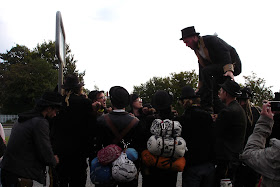Nat was the first person travelling in the tradition of the German guilds that I had met and talked to about it. Through him I also met several other people doing the same thing and I feel quite privileged to have had an opportunity to do so. Meeting journeymen travelling in the tradition is not that common an occurrence in Britain, even amongst craftspeople. Some of those that he put me in contact with I would now also call friends.
 |
| Journeymen in Berlin around 1900 Image from: http://denstoredanske.dk/Erhverv,_karriere_og_ledelse/Håndværk/Håndværk_generelt/naver |
The normal length of travelling is three years and a long day. The long day is the part that lets someone keep going if they don't feel that it's time to stop yet. During their travels, journeymen carry a map with a circle marking an area with a fifty kilometre radius and their hometown at the centre. They are not allowed to go into that area for the whole of their time travelling in the tradition (unless there is an emergency, such as a member of their immediate family becoming seriously ill).
Nat himself is Danish and came into the tradition as a naver, which is the Danish equivalent of the German journeyman. Danish navers are not as frequently encountered as German gesellen and I was told that Nat was one of few Danish navers currently travelling at that point. He himself was travelling in the German tradition, having been introduced into the tradition by a German journeyman.
After over five years, it was time for Nat to go home.
Having been notified in advance of the day and location, Nat's friends and family were gathering next to a town sign on a busy road just outside of Copenhagen. The weather was bright with some cloud and the first chill of autumn on the breeze. As the journeymen would be hitchhiking to the spot, times were very approximate - he would be there some time after 3.30pm.
I could feel the excitement build, with people crossing the highway to see as far as possible along it. It was great to have a chance to meet and chat with the others who were also waiting. Four journeymen arrived early, then headed back down the road to find the others so that they could all arrive together.
Eventually, at about 5pm, a group of around twenty figures wearing the distinctive clothes and carrying the spiral Stenz sticks of the gesellen came into view. All of the friends and family gathered on the other side of the sign. As they got closer, the cluster of journeymen separated into a line and, walking in single file, the line snaked around and back on itself.
It wound up alleyways and across the road, before finally gathering on an island in the middle of the carriageway. There, a few words were said between them, there was a cheer and Nat drained the last of a bottle.
The group approached the other side of the sign from the waiting friends and family. Not all of the people in it were currently journeymen, some I knew had already finished their own travels but had put on their wandering clothes again for this day.
They then formed two lines with their stenz sticks held between them.
Nat climbed up onto this 'ladder' and clambered up to the sign. He then climbed back over, his journeying years done. I knew that in his pocket, in accordance with tradition, would be five euros: the same amount that he left with.
There was still one more thing to do while we were there. When he left, Nat's friends and family had put letters for him into a bottle which was then sealed and buried at a certain depth five paces from the sign. Traditionally, Nat would dig the hole to bury it and his family would try to throw handfuls of earth back in to show that they didn't want him to go, while his journeymen friends defended the hole from being refilled.
There were a few toots on car horns from passing motorists as the spade was brought out and Nat started to dig to retrieve the bottle, with some journeyman songs being sung at the same time.
Eventually, other friends took over the work to give him a chance to talk to those who had come to see him.
The next day, there was another party, although everyone seemed a little more subdued after the drinking of the night before (together with the partying that had gone on before they arrived at the sign). All of the journeymen got up on a stage in front of the family and friends and short speeches were made before some traditional travelling songs were sung. It was simple but also quite moving.
Nat's family had brought clothes with them, which he changed into from his travelling clothes while the songs continued. Then there was a quiz. All of the stenz sticks were put into the middle and Nat had to guess whose stick each one was. Not easy with so many travelling companions there!
It was great to catch up with old friends at the party, as well as meeting new ones.
I hope that these posts allow English-speaking people who haven't met journeymen travelling in the German tradition to learn a bit more about it. It would be good to think that they might open a few extra doors to those travelling in the UK and elsewhere, where the traditions are less well known and understood than in continental Europe.
And, of course, good luck to Nat for his next adventures!










No comments:
Post a Comment